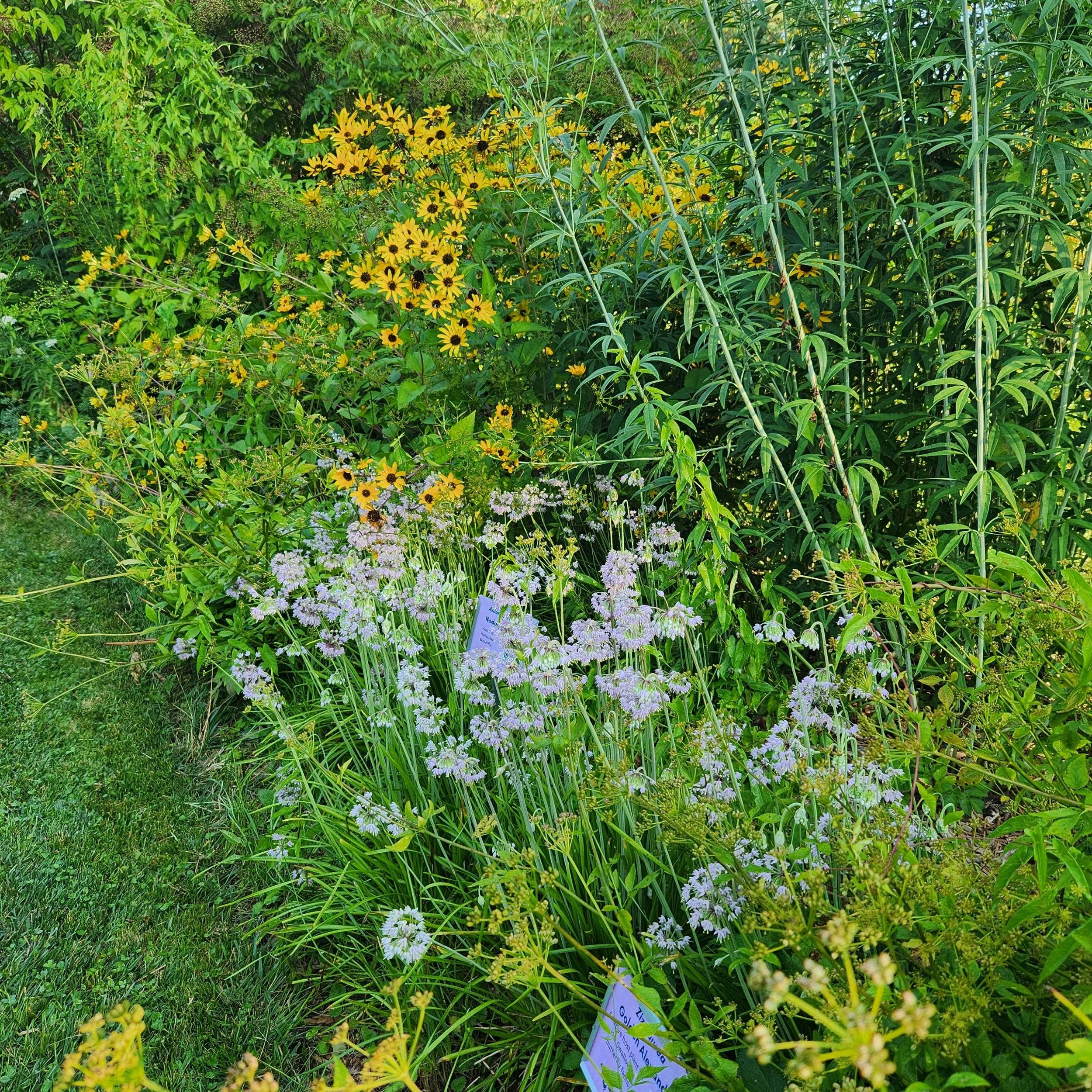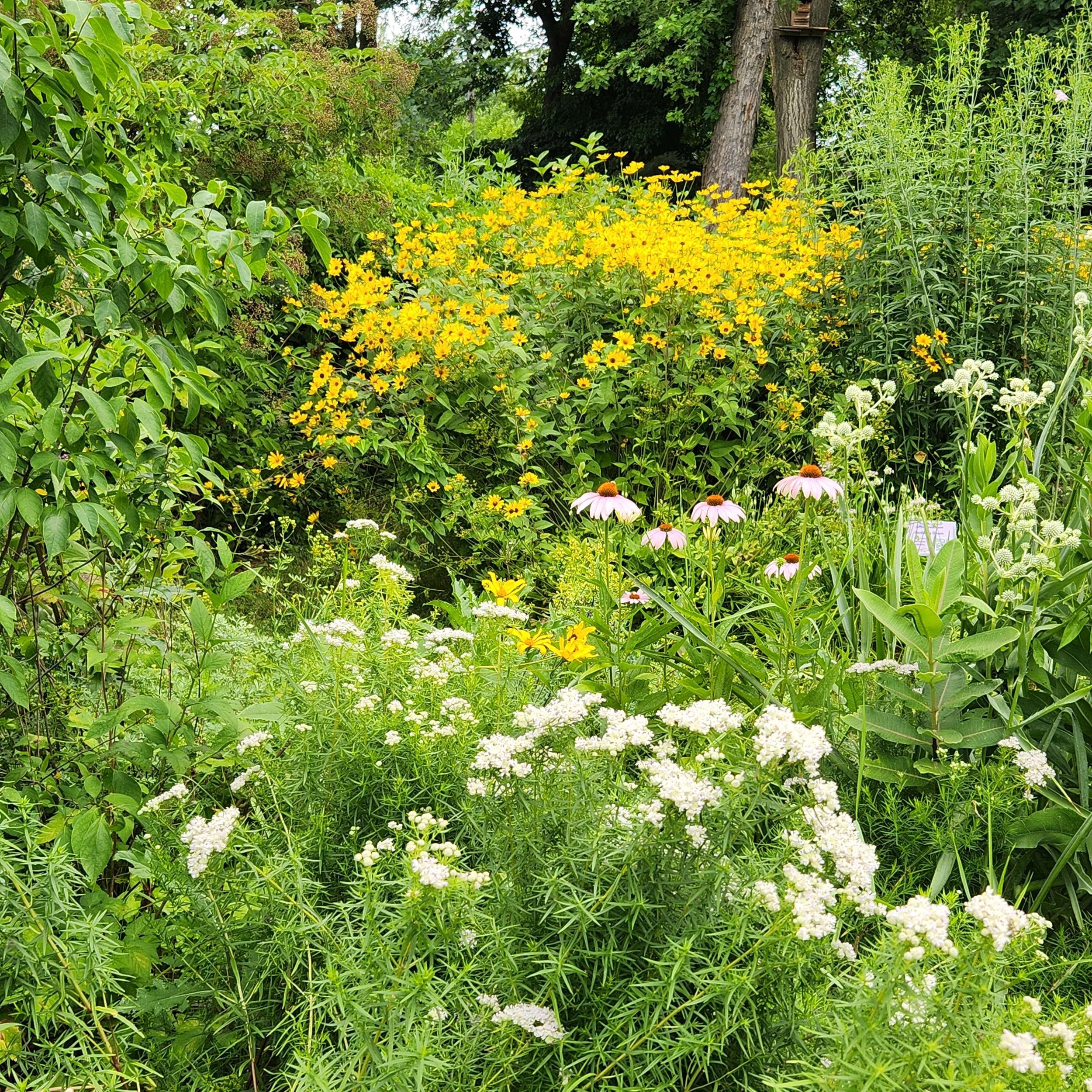Heliopsis helianthoides, False Sunflower, Quart pot
Heliopsis helianthoides, False Sunflower
FS-PS, Zone 3, blooms June-September, 5’ x 2-3’, deer and rabbit resistant, medium wet to medium dry, grows in most soil conditions.
Growing best in full sun to partial shade, False Sunflower may need support in shadier conditions. This species tolerates some drought and a wide range of soil types, including nutrient-poor soils. Unlike true sunflowers, it produces seed in both the ray and disc lowers. Blooming occurs in summer, beginning in July to August and extends for up to two months, making it one of the earliest blooming sunflowers. The plant grows via fibrous roots and tends to be a short-lived perennial. It does self-seed and may spread widely, becoming weedy in some landscape settings. Thus, you can share specimens of this plant with like-minded pollinator-friendly friends. We grew it for the first time in 2020 and found 3 plants made a nice stand for a first year perennial. By seasons end, the plants looked a little bent over and weary, but pretty good for the end of the season.
All Helianthus are considered Keystone Plants, essential for preserving our wildlife. They support over 66 species of butterflies and moths and ove 50 specialist bees.
Attracts native bees, honey bees, butterflies, bee flies, Hummingbird Moths and beetles. False sunflower offers both nectar and pollen for over two months and attracts many beneficial insects. Syrphid flies and Soldier Beetles visit for nectar and are important because they also help control aphids. The ground nesting bee, Holcopasites heliopis, is a specialist pollinator of False Sunflower. Birds utilize the seed as a food source and stems provide winter cover for beneficial insects.
DA Comment - During the drought of 2020, by Sept. our False SF looked extremely weary and due to the drought the plants were weakend and had a case of aphids. We haven’t seen that since. They are slightly “messy” and this may turn off some gardeners. In retrospect, we started observing more closely and have embraced this plant for its ability to support specialist bees and so many others.
Host plant for many moths and the Painted Lady and Silvery Checkerspot Butterflies.
Heliopsis helianthoides, False Sunflower
FS-PS, Zone 3, blooms June-September, 5’ x 2-3’, deer and rabbit resistant, medium wet to medium dry, grows in most soil conditions.
Growing best in full sun to partial shade, False Sunflower may need support in shadier conditions. This species tolerates some drought and a wide range of soil types, including nutrient-poor soils. Unlike true sunflowers, it produces seed in both the ray and disc lowers. Blooming occurs in summer, beginning in July to August and extends for up to two months, making it one of the earliest blooming sunflowers. The plant grows via fibrous roots and tends to be a short-lived perennial. It does self-seed and may spread widely, becoming weedy in some landscape settings. Thus, you can share specimens of this plant with like-minded pollinator-friendly friends. We grew it for the first time in 2020 and found 3 plants made a nice stand for a first year perennial. By seasons end, the plants looked a little bent over and weary, but pretty good for the end of the season.
All Helianthus are considered Keystone Plants, essential for preserving our wildlife. They support over 66 species of butterflies and moths and ove 50 specialist bees.
Attracts native bees, honey bees, butterflies, bee flies, Hummingbird Moths and beetles. False sunflower offers both nectar and pollen for over two months and attracts many beneficial insects. Syrphid flies and Soldier Beetles visit for nectar and are important because they also help control aphids. The ground nesting bee, Holcopasites heliopis, is a specialist pollinator of False Sunflower. Birds utilize the seed as a food source and stems provide winter cover for beneficial insects.
DA Comment - During the drought of 2020, by Sept. our False SF looked extremely weary and due to the drought the plants were weakend and had a case of aphids. We haven’t seen that since. They are slightly “messy” and this may turn off some gardeners. In retrospect, we started observing more closely and have embraced this plant for its ability to support specialist bees and so many others.
Host plant for many moths and the Painted Lady and Silvery Checkerspot Butterflies.
Heliopsis helianthoides, False Sunflower
FS-PS, Zone 3, blooms June-September, 5’ x 2-3’, deer and rabbit resistant, medium wet to medium dry, grows in most soil conditions.
Growing best in full sun to partial shade, False Sunflower may need support in shadier conditions. This species tolerates some drought and a wide range of soil types, including nutrient-poor soils. Unlike true sunflowers, it produces seed in both the ray and disc lowers. Blooming occurs in summer, beginning in July to August and extends for up to two months, making it one of the earliest blooming sunflowers. The plant grows via fibrous roots and tends to be a short-lived perennial. It does self-seed and may spread widely, becoming weedy in some landscape settings. Thus, you can share specimens of this plant with like-minded pollinator-friendly friends. We grew it for the first time in 2020 and found 3 plants made a nice stand for a first year perennial. By seasons end, the plants looked a little bent over and weary, but pretty good for the end of the season.
All Helianthus are considered Keystone Plants, essential for preserving our wildlife. They support over 66 species of butterflies and moths and ove 50 specialist bees.
Attracts native bees, honey bees, butterflies, bee flies, Hummingbird Moths and beetles. False sunflower offers both nectar and pollen for over two months and attracts many beneficial insects. Syrphid flies and Soldier Beetles visit for nectar and are important because they also help control aphids. The ground nesting bee, Holcopasites heliopis, is a specialist pollinator of False Sunflower. Birds utilize the seed as a food source and stems provide winter cover for beneficial insects.
DA Comment - During the drought of 2020, by Sept. our False SF looked extremely weary and due to the drought the plants were weakend and had a case of aphids. We haven’t seen that since. They are slightly “messy” and this may turn off some gardeners. In retrospect, we started observing more closely and have embraced this plant for its ability to support specialist bees and so many others.
Host plant for many moths and the Painted Lady and Silvery Checkerspot Butterflies.





